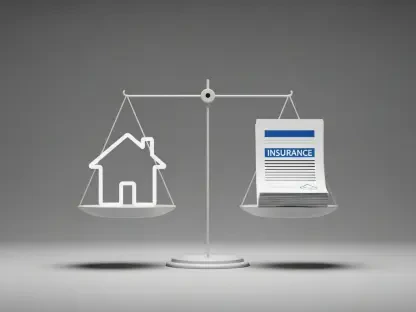Setting the Stage: A Climate Crisis Meets Market Dynamics
In a world where climate-related disasters are costing the global insurance industry billions annually, the stakes for strategic adaptation have never been higher, placing the sector at a critical intersection of environmental necessity and financial stability. The insurance industry grapples with the dual challenge of escalating natural catastrophes and intensifying political pushback against net-zero goals. Aviva, a titan in the global insurance market, emerges as a beacon of resilience, steadfastly pursuing climate-focused strategies despite a polarized landscape. This market analysis delves into how Aviva is shaping industry trends, navigating regulatory volatility, and responding to client demands, while offering projections on the future of climate strategies in insurance. The purpose is to uncover actionable insights for stakeholders aiming to balance sustainability with profitability in an increasingly unpredictable environment.
Market Trends and In-Depth Analysis
Historical Context: Insurance Meets Climate Risk
The insurance industry’s engagement with climate risks is not a recent phenomenon but a decades-long evolution driven by mounting financial losses. Significant events, such as major hurricanes in the early 1990s, forced insurers to rethink risk assessment, integrating environmental factors into underwriting models. Over time, the frequency and severity of extreme weather events have underscored the urgency of this shift, with natural disasters becoming a top driver of claims payouts. This historical backdrop reveals a market compelled to adapt, where ignoring climate impacts is no longer a viable option but a direct threat to solvency and client trust, setting the foundation for leaders like Aviva to prioritize sustainability as a core business imperative.
Aviva’s Strategic Positioning: A Dual Focus on Risk and Returns
Aviva distinguishes itself in the current market by weaving climate adaptation into the fabric of its risk management framework. Under strong leadership, the company has recognized that the soaring costs of disasters—ranging from floods in Europe to wildfires in North America—demand proactive measures to protect assets and ensure insurability. Recent financial data highlights a 22% surge in half-year operating profit to £1 billion, illustrating that a climate-conscious approach can align seamlessly with robust economic performance. However, this path is fraught with hurdles, including the need to balance investments in resilience with premium structures that remain competitive, especially as political narratives in key markets challenge the immediacy of climate action.
Client-Driven Shifts: Resilience as a Market Differentiator
A notable trend reshaping the insurance landscape is the rising client expectation for recognition of climate resilience investments. Businesses and individuals implementing protective measures, such as flood barriers or fire-resistant infrastructure, are pushing insurers to adjust policy terms accordingly. Aviva is at the forefront of this shift, embedding resilience factors into its underwriting practices, which not only strengthens client loyalty but also positions it as a market innovator. This dynamic presents both a challenge in accurately pricing reduced risks and an opportunity to foster a cycle of adaptation, where client actions spur broader industry standards, potentially redefining competitive edges in the sector.
Political and Regulatory Headwinds: Navigating Uncertainty
External pressures, particularly in politically volatile regions like the United States, add a layer of complexity to the market environment. Regulatory fluctuations driven by shifting environmental policies create ambiguity in risk pricing and long-term planning, impacting insurers with global footprints like Aviva. Legal disputes over climate science further muddy the waters, amplifying uncertainty in key markets. Despite these challenges, the industry maintains a pragmatic outlook, understanding that while political cycles may oscillate every few years, climate risks remain a persistent and escalating threat, necessitating unwavering strategic commitment.
Emerging Innovations: Technology and Market Opportunities
Looking at current market developments, technological advancements in climate modeling and data analytics are poised to revolutionize risk assessment over the coming years, from 2025 to 2027. These tools enable insurers to predict and mitigate potential losses with greater precision, closing gaps in coverage exposed by recent record-high uninsured losses from natural catastrophes. Markets like London are emerging as hubs for climate-focused insurance solutions, leveraging a history of innovation to drive new product offerings tailored to adaptation needs. Companies that capitalize on these trends, as Aviva is doing, stand to gain significant competitive advantages, reshaping market dynamics toward a synergy of sustainability and profitability.
Reflecting on Insights: Strategic Pathways Forward
Looking back, this analysis illuminated Aviva’s role as a market leader in integrating climate strategies with financial success, navigating a landscape marked by client demands for resilience recognition and persistent regulatory volatility. The examination of historical trends, current innovations, and political challenges painted a picture of an industry at a critical juncture, where adaptation was not merely an option but a necessity for survival. Key implications included the undeniable link between environmental and economic stability, a connection Aviva leveraged to maintain strong performance. For stakeholders, the path forward involved investing in advanced climate modeling to refine risk strategies, collaborating with clients to incentivize protective measures, and advocating for consistent regulatory frameworks to minimize uncertainty. As the market continued to evolve, the enduring lesson was clear: embracing innovation and resilience offered the surest route to long-term viability in a changing world.









